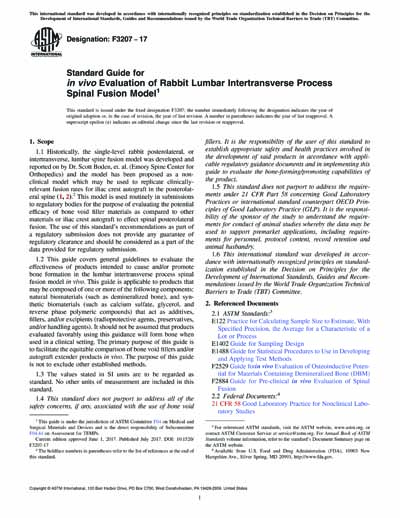Most recent
ASTM F3207-17
Standard Guide for in vivo Evaluation of Rabbit Lumbar Intertransverse Process Spinal Fusion Model
1.1 Historically, the single-level rabbit posterolateral, or intertransverse, lumbar spine fusion model was developed and reported on by Dr. Scott Boden, et. al. (Emory Spine Center for Orthopedics) and the model has been proposed as a non-clinical model which may be used to replicate clinically-relevant fusion rates for iliac crest autograft in the posterolateral spine (1, 2).2 This model is used routinely in submissions to regulatory bodies for the purpose of evaluating the potential efficacy of bone void filler materials as compared to other materials or iliac crest autograft to effect spinal posterolateral fusion. The use of this standard’s recommendations as part of a regulatory submission does not provide any guarantee of regulatory clearance and should be considered as a part of the data provided for regulatory submission.
1.2 This guide covers general guidelines to evaluate the effectiveness of products intended to cause and/or promote bone formation in the lumbar intertransverse process spinal fusion model in vivo. This guide is applicable to products that may be composed of one or more of the following components: natural biomaterials (such as demineralized bone), and synthetic biomaterials (such as calcium sulfate, glycerol, and reverse phase polymeric compounds) that act as additives, fillers, and/or excipients (radioprotective agents, preservatives, and/or handling agents). It should not be assumed that products evaluated favorably using this guidance will form bone when used in a clinical setting. The primary purpose of this guide is to facilitate the equitable comparison of bone void fillers and/or autograft extender products in vivo. The purpose of this guide is not to exclude other established methods.
1.3 The values stated in SI units are to be regarded as standard. No other units of measurement are included in this standard.
1.4 This standard does not purport to address all of the safety concerns, if any, associated with the use of bone void fillers. It is the responsibility of the user of this standard to establish appropriate safety and health practices involved in the development of said products in accordance with applicable regulatory guidance documents and in implementing this guide to evaluate the bone-forming/promoting capabilities of the product.
1.5 This standard does not purport to address the requirements under 21 CFR Part 58 concerning Good Laboratory Practices or international standard counterpart OECD Principles of Good Laboratory Practice (GLP). It is the responsibility of the sponsor of the study to understand the requirements for conduct of animal studies whereby the data may be used to support premarket applications, including requirements for personnel, protocol content, record retention and animal husbandry.
1.6 This international standard was developed in accordance with internationally recognized principles on standardization established in the Decision on Principles for the Development of International Standards, Guides and Recommendations issued by the World Trade Organization Technical Barriers to Trade (TBT) Committee.
Content Provider
ASTM International [astm]






